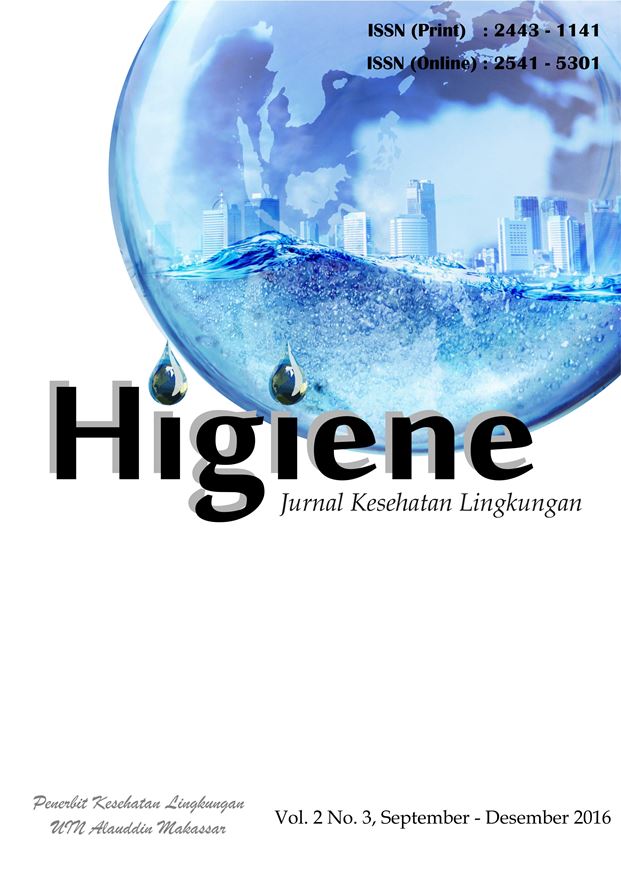Gambaran Epidemiologi Infeksi Oportunistik Tuberkulosis Pada Penderita HIV di Puskesmas Percontohan HIV/AIDS Kota Makassar Tahun 2015
Abstract
Tuberculosis (TB) is a disease of opportunistic infections most often found in patients with HIV / AIDS. This study aims to describe the epidemiology of tuberculosis Opportunistic Infections In HIV patients at the health center in Makassar pilot HIV 2015. This type of research is quantitative descriptive research design. The population in this research that all patients with HIV / AIDS were diagnosed with tuberculosis infection in specimen community health centers HIV / AIDS in the city of Makassar as many as 14 people with sampling techniques using total sampling.
The results showed that the characteristics of HIV patients with tuberculosis infection based on gender most affected are males by 11 (78.6%) of respondents, by age most affected is the 26-45 year 8 (57.1%) of people, based education at most that low educated as much as 8 (57.1%) of people, based on the work that people who work as many as eight (57.1%) of people, based on revenue at most that low-income by 8 (57.1%) of people, by the time diagnosis is categorized in a long time that as many as 14 (100%) of people, based on the history of contact at most that the patient had no history of contact as many as 11 (78.6%) of people, based on the density of dwelling at most that do not qualify as much as 9 ( 35.7%) of people, based on home lighting most that do not qualify as many as 11 (78.6%) of people, and based on home ventilation most that do not qualify as many as 10 (71.4%) persons.
Keywords : opportunistic infections, tuberculosis, HIV
References
Ayu Desy Permitasari. “Faktor Risiko Terjadinya Koinfeksi Tuberkulosis pada Pasien HIV/AIDS di Rsup Dr. Kariadi Semarang”. Skripsi. Semarang: Sekolah Pascasarjana
Departemen Kesehatan Republik Indonesia. Standar Prosedur Operasional Klinik Sanitasi Untuk Puskesmas. Jakarta: Direktorat Jenderal Pengendalian Penyakit dan Penyehatan Lingkungan Kementerian Kesehatan Republik Indonesia, 2002.
Departemen Kesehatan Republik Indonesia. Pedoman Nasional Tatalaksana Klinis Infeksi HIV dan Terapi Antiretroviral. Jakarta: Direktorat Jenderal Pengendalian Penyakit dan Penyehatan Lingkungan Kementerian Kesehatan Republik Indonesia, 2011.
Dinas Kesehatan Kota Makassar. Profil Kesehatan Kota Makassar Tahun 2013. Makassar: Dinas Kesehatan Kota Makassar, 2014.
Dinas Kesehatan Provinsi Sulawesi Selatan. Profil Kesehatan Provinsi Sulawesi Selatan Tahun 2014. Makassar: Dinas Kesehatan Provinsi Sulawesi Selatan, 2014.
Fatimah Sitti. 2008. “Faktor Kesehatan Lingkungan Rumah Yang Berhubungan Dengan kejadian TB Paru di Kabupaten Cilacap”. Tesis. Semarang: Sekolah Pascasarjana Universitas Diponegoro, 2008 (Diakses 15 Mei 2015).
Kementerian Kesehatan Republik Indonesia. Data dan Informasi Tahun 2014 (Profil Kesehatan Indonesia). Jakarta: Kementerian Kesehatan RI, 2015.
Kementerian Kesehatan Republik Indonesia. Profil Kesehatan Indonesia. Jakarta: Kementerian Kesehatan RI, 2012.
Notoatmodjo, S. (2003). Ilmu Kesehatan Masyarakat. Jakarta : Rineka Cipta
Puskesmas Makkasau. Data Angka Kasus TB/HIV Tahun 2014-2015. Makassar: Puskesmas Makkasau; 2015.
Puskesmas Jumpandang Baru. Data Angka Kasus TB/HIV Tahun 2014-2015. Makassar: Puskesmas Jumpandang Baru; 2015
Puskesmas Jongaya. Data Angka Kasus TB/HIV Tahun 2014-2015. Makassar: Puskesmas Jongaya;
Ruswanto Bambang. “Analisis Spasial Sebaran Kasus Tuberkulosis Paru Ditinjau dari Faktor Lingkungan Dalam dan Luar Rumah di Kabupaten Pekalongan”. Tesis. Semarang: Universitas Diponegoro, 2010.
Shihab, M. Quraish. Tafsir Al-Mishbah: Pesan, Kesan, dan Keserasian al-Qur’an, vol. 9. Jakarta: Lentera Hati, 2002.


